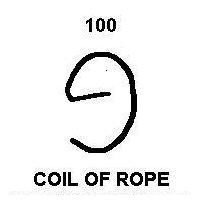|
|
Ancient
Numeration systems
Ancient
numeration systems can be an interesting topic of study for
elementary and middle school students. First they can learn more about
the mathematics of our own system by comparing it to the systems of
ancient civilizations. In addition they can learn more about those
ancient civilizations from understanding better how they wrote numbers.
Objective: Students will be able to demonstrate their understanding of
the four different numeration systems by accurately adding and
subtracting two numbers, and showing the regrouping process in the
appropriate numeration system.
- e.g. 5825 + 6941 written correctly in the appropriate system, regrouped as needed, and then calculated accurately.
|

This graphic from http://pics4learning.com/
|
|
Babylonian
The
Babylonian cuneiform method of recording quantities, approximately 5000
years old, is among the oldest numeral systems in existence. They
developed a base-60 (sexidecimal) system with numbers less than sixty
represented in base-ten. They also developed a positional system for
writing larger numbers with fewer symbols, But they had no number for
zero, so their numerals can be difficult to interpret.
|
 |
For
a more thorough look at the Babylonian system, see the Babylonian
mathematics website from the University of Edinburgh.
The Babylonian
numerals link
has a terrific chart that shows the symbols for the numbers 1-59...and
then shows how to write a number as large as 424000 in
Babylonian–1,57,46,40 written in Babyonian cuneiform symbols!
How did they multiply in the Babylonian system? They used a table of
squares to calculate products using the following relationship: ab=[(a + b)2 - a2- b2 ]/ 2. More about this at this site from the United Kingdom about Babylonian
Mathematics.
The
Babylonian sexidecimal system has its influence in our own world today.
Angle measurement (360 degrees equals a circle) and time measurements
(60 seconds equals one minute) are two examples.

|
Egyptian
The
Egyptian method for recording quantitities is based on 10 with a symbol
for 1, ten, and each successive power of ten. A distinct hieroglypic
was used for each power of 10. There was no symbol for zero, therefore
a particular symbol was omitted in a numeral when that multiple of ten
was not part of the number.
|
For
a more thorough look at the Egyptian system, see the Egyptian
mathematics website from the University of Edinburgh.
The Egyptian
numerals link
has a terrific chart that shows the symbols for the Egyptian numeral
hieroglyphs...and then shows how to write a number as large as 4622
using Egyptian numeral hieroglyphs.
|
Mayan
The
Mayan system was a base- 20 system (vigesimal) that used a system of
bars and dots in a vertical place value system. A dot stood for one and
a bar stood for five.
For more information
about this system, see this Mayan math site.
|

|

|
Roman
The Roman method (no
place value, instead an additive system, rules of subtraction, base ten
with fives)
|
For
a more in depth look at Roman numerals, see this "Ask Dr.
Math" website about Roman numerals.
Here Dr. Math summarizes the basics of the Roman system, including a
summary of the rules of subtraction for the Roman system. This site is
part of the larger "Ask Dr. Math
website," ,
a searchable
resource for answering mathematics questions online. This is in turn a
part of the larger "Math Forum" website at Drexel
University– a valuable resource for mathematics educators to which you may subscribe. There is also a "Roman Numeral Calculator"
you might enjoy using with your students (thanks to EDUC 3/543 student
Lisa Jernstedt Webster for bringing this to our attention).
Further Exploration Written by South Korean students, this website about
Oriental Mathematics
is part of an award winning ThinkQuest. It introduces students to the
Babylonian, Egyptian, Mayan, and Roman numeration systems and provides
more background information about each. Its explanation of each system,
while a bit terse at times, has good graphics that show what the
symbols actually looked like and goes into greater depth into the
number theory and history behind these fascinating systems.
|
|
|





